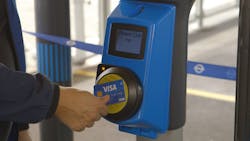Visa Furthers the Development of Contactless Fare Collection
Visa recently launched its Visa Global Transit Solutions, a program designed to make transit payments easier. The Global Transit Solutions allow the accelerated use of debit, credit and pre-paid accounts at the faregate or on a bus reader. Increased accessibility and ease for riders to purchase their tickets has the ability to attract riders and increase ridership. Contactless payments like the Global Transit Solutions have added benefits in that riders can use their debit cards as a form of payment — a method that visitors to cities can easily use without needing to get a separate pass for the transit system.
Visa partnered with Transport for London, working to assist the system to move away from cash and toward contactless payments on both TfL's bus and rail systems.
The features of the program are:
- Consulting: The Visa Global Transit Solutions team provides support for contactless payments implementation, providing guidance and hands-on assistance.
- Frameworks: Back-office framework manages contactless payments regardless of transit operators’ size or fare structure.
- Tools and Standards: Visa Global Transit Solutions' includes the payment technologies available to mass transit operators; it also provides security.
- Future of Transportation: Visa looks to engage with transit operators, technology enablers, financial technology companies and others to examine all aspects of the consumer journey.
Nick Mackie, head of Contactless at Visa Europe, said, "The best way to characterize it is it’s a combination of a number of activities that we’ve been engaged on for at least the past five years — probably closer to 10 ... Where the so called TfL project came to be, wherein 2012 it began its launch of contactless travel on London buses. There was a lot of work done in the run up to that where new transaction models that were Europe-specific and in fact, really TfL-specific, that were created and introduced. We also learned an awful lot about contactless at the same time, because back in 2012, contactless payments only accounted for about 1 in 200 of our face-to-face payments. It wasn’t anything like what we see in the UK and a number of other markets. To bring some contrast to that, today in the UK nearly 1 in 2 payments are contactless. I think this month for the very first time, the majority — just over 52 percent — of our face-to-face payments are contactless."
Mackie explained that Visa learned a lot during the launch of the contactless program in London.
"Through our partnership we again learned and developed information around transit. What we found was that we developed this sort of knowledge and expertise and it’s been absolutely instrumental to TfL and the market generally in making the program the success that it deserved to be," said Mackie. "With the general contactless and the benefit that can bring, not just to transport operators, but to cities and entire economies in terms of driving the move toward digital. We figured that it was very much our role to think about how we can accelerate that further; how we can increase the overall impact of these programs to make them happen more quickly and make them more impactful and beneficial."
Management of the back system
"The program really came from that and it was leveraging on current experiences and expertise that we developed. We also recognized that we had some gaps in our understanding. We took our expert team and had them recruit the right types of people with the right backgrounds and perspectives so that we had a very solid consulting platform that we could provide," said Mackie. "We also looked at what new rules and framework we needed."
When it comes to management, Visa does not have a direct relationship with the transit operator. When it comes to contactless payments, Visa operates in a similar way to a relationship with a bank.
"What we are doing is providing all the support and maintenance that they require. It really works as a tool adjacent to the technology for the customer. When it comes to transit, it is really deeply integrated into the system," Mackie added. "With TfL, they had to change terminals across their sprawling reach in London. We’re deeply involved as to how they install our framework. There is a much more consultative approach that we need to take. The initial phase is planning out how they would integrate it."
Visa also works with the management of how transit agency customers are informed of the fare payment transformation. When it comes to the implementation and management of a system Visa consults the transit agency as to how best it would be to roll it out.
"It’s a question that we ask our merchants in the very early phase. We ask, what is their vision that we are trying to achieve here and how is it that we can improve the operations and the business of the transport merchant and for the transit ridership. Often they’ll come back and say ‘Here’s what we want to do,’ and we’ll look it over and kind of kick the tires on that," said Mackie. "When it comes to London they began with buses across the city and when it went live in 2012, it was the red buses only at that state. Cities like New York will also have this sort of phase one of implementing it. It makes sure that the systems are working correctly and that everything is working throughout the journey. It turns around at a relatively quick pace and we see a big bang roll-out."
